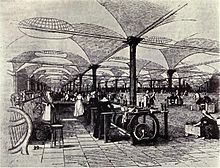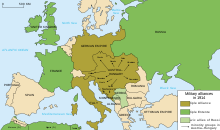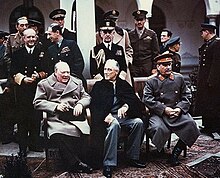
Main article: Early modern period
The Renaissance was a period of cultural change originating in Florence and later spreading to the rest of Europe. in the 14th century. The rise of a new humanism was accompanied by the recovery of forgotten classical Greek and Arabic knowledge from monastic libraries, often re-translanted from Arabic into Latin.[62][63][64] The Renaissance spread across Europe between the 14th and 16th centuries: it saw the flowering of art, philosophy, music, and the sciences, under the joint patronage of royalty, the nobility, the Roman Catholic Church, and an emerging merchant class.[65][66][67] Patrons in Italy, including the Medici family of Florentine bankers and the Popes inRome, funded prolific quattrocento and cinquecento artists such as Raphael, Michelangelo, andLeonardo da Vinci.[68][69]
Political intrigue within the Church in the mid-14th century caused the Great Schism. During this forty-year period, two popes—one in Avignon and one in Rome—claimed rulership over the Church. Although the schism was eventually healed in 1417, the papacy's spiritual authority had suffered greatly.[70]
The Church's power was further weakened by the Protestant Reformation (1517–1648), initially sparked by the works of German theologian Martin Luther, a result of the lack of reform within the Church. The Reformation also damaged the Holy Roman Empire's power, as German princes became divided between Protestant and Roman Catholic faiths.[71] This eventually led to the Thirty Years War (1618–1648), which crippled the Holy Roman Empire and devastated much ofGermany, killing between 25 and 40 percent of its population.[72] In the aftermath of the Peace of Westphalia, France rose to predominance within Europe.[73] The 17th century in southern and eastern Europe was a period of general decline.[74] Eastern Europe experienced more than 150 famines in a 200-year period between 1501 to 1700.[75]
The Renaissance and the New Monarchs marked the start of an Age of Discovery, a period of exploration, invention, and scientific development.[76] According to Peter Barrett, "It is widely accepted that 'modern science' arose in the Europe of the 17th century (towards the end of the Renaissance), introducing a new understanding of the natural world."[62] In the 15th century, Portugal and Spain, two of the greatest naval powers of the time, took the lead in exploring the world.[77][78] Christopher Columbusreached the New World in 1492, and soon after the Spanish and Portuguese began establishing colonial empires in the Americas.[79] France, the Netherlands and England soon followed in building large colonial empires with vast holdings in Africa, the Americas, and Asia.
18th and 19th centuries
Main article: Modern history
The Age of Enlightenment was a powerful intellectual movement during the 18th century promoting scientific and reason-based thoughts.[80][81][82] Discontent with the aristocracy and clergy's monopoly on political power in France resulted in the French Revolution and the establishment of the First Republic as a result of which the monarchy and many of the nobility perished during the initial reign of terror.[83]Napoleon Bonaparte rose to power in the aftermath of the French Revolution and established the First French Empire that, during theNapoleonic Wars, grew to encompass large parts of Europe before collapsing in 1815 with the Battle of Waterloo.[84][85]
Napoleonic rule resulted in the further dissemination of the ideals of the French Revolution, including that of thenation-state, as well as the widespread adoption of the French models of administration, law, andeducation.[86][87][88] The Congress of Vienna, convened after Napoleon's downfall, established a new balance of power in Europe centred on the five "Great Powers": theUnited Kingdom, France, Prussia, Habsburg Austria, and Russia.[89]
This balance would remain in place until theRevolutions of 1848, during which liberal uprisings affected all of Europe except for Russia and the United Kingdom. These revolutions were eventually put down by conservative elements and few reforms resulted.[90] In 1867, the Austro-Hungarian empire wasformed; and 1871 saw the unifications of both Italy and Germany as nation-states from smaller principalities.[91] Likewise, in 1878 the Congress of Berlin has conveyed formal recognition to the de facto independent principalities ofMontenegro, Serbia and Romania.
The Industrial Revolution started in Great Britain in the last part of the 18th century and spread throughout Europe. The invention and implementation of new technologies resulted in rapid urban growth, mass employment, and the rise of a new working class.[92] Reforms in social and economic spheres followed, including the first laws on child labour, the legalisation of trade unions,[93] and the abolition of slavery.[94] In Britain, the Public Health Act 1875 was passed, which significantly improved living conditions in many British cities.[95]Europe’s population doubled during the 18th century, from roughly 100 million to almost 200 million, and doubled again during the 19th century.[96] In the 19th century, 70 million people left Europe in migrations to various European colonies abroad and to the United States.[97]
20th century to present
Main articles: Modern era and History of Europe
See also: World War I, Great Depression, Interwar period, World War II, Cold War, and History of the European Union
Two World Wars and an economic depression dominated the first half of the 20th century. World War I was fought between 1914 and 1918. It started when Archduke Franz Ferdinand of Austriawas assassinated by the Bosnian Serb Gavrilo Princip.[98] Most European nations were drawn into the war, which was fought between the Entente Powers (France, Belgium, Serbia, Portugal,Russia, the United Kingdom, and later Italy, Greece, Romania, and the United States) and theCentral Powers (Austria-Hungary, Germany, Bulgaria, and the Ottoman Empire). The War left around 40 million civilians and military dead.[99] Over 60 million European soldiers were mobilised from 1914–1918.[100]
Partly as a result of its defeat Russia was plunged into the Russian Revolution, which threw down the Tsarist monarchy and replaced it with the communist Soviet Union.[101] Austria-Hungary and the Ottoman Empire collapsed and broke up into separate nations, and many other nations had their borders redrawn. The Treaty of Versailles, which officially ended World War I in 1919, was harsh towards Germany, upon whom it placed full responsibility for the war and imposed heavy sanctions.[102]
Economic instability, caused in part by debts incurred in the First World War and 'loans' to Germany played havoc in Europe in the late 1920s and 1930s. This and the Wall Street Crash of 1929 brought about the worldwide Great Depression. Helped by the economic crisis, social instability and the threat of communism, fascist movements developed throughout Europe placing Adolf Hitler of Nazi Germany,Francisco Franco of Spain and Benito Mussolini of Italy in power.[103][104]
In 1933, Hitler became the leader of Germany and began to work towards his goal of building Greater Germany. Germany re-expanded and took back the Saarland and Rhineland in 1935 and 1936. In 1938,Austria became a part of Germany too, following the Anschluss. Later that year, Germany annexed the German Sudetenland, which had become a part of Czechoslovakia after the war. This move was highly contested by the other powers, but ultimately permitted in the hopes of avoiding war and appeasing Hitler.
Shortly afterwards, Poland and Hungary started to press for the annexation of parts of Czechoslovakia with Polish and Hungarian majorities. Hitler encouraged the Slovaks to do the same and in early 1939, the remainder of Czechoslovakia was split into the Protectorate of Bohemia and Moravia, controlled by Germany, and the Slovak Republic, while other smaller regions went to Poland and Hungary. With tensions mounting between Germany and Poland over the future of Danzig, the Germans turned to the Soviets, and signed the Molotov-Ribbentrop Pact. Germany invaded Poland on 1 September 1939, prompting France and the United Kingdom to declare war on Germany on 3 September, opening theEuropean theatre of World War II.[105][106] The Soviet invasion of Poland started on 17 September and Poland fell soon thereafter.
On 24 September, the Soviet Union attacked the Baltic countries and later, Finland. The British hoped to land at Narvik and send troops to aid Finland, but their primary objective in the landing was to encircle Germany and cut the Germans off from Scandinavian resources. Nevertheless, the Germans knew of Britain's plans and got to Narvik first, repulsing the attack. Around the same time, Germany moved troops into Denmark, which left no room for a front except for where the last war had been fought or by landing at sea. The Phoney War continued.
In May 1940, Germany attacked France through the Low Countries. France capitulated in June 1940. However, the British refused to negotiate peace terms with the Germans and the war continued. By August Germany began a bombing offensive on Britain, but failed to convince the Britons to give up.[107] In 1941, Germany invaded the Soviet Union in the ultimately unsuccessfulOperation Barbarossa.[108] On 7 December 1941 Japan's attack on Pearl Harbor drew the United States into the conflict as allies of the British Empire and other allied forces.[109][110]
After the staggering Battle of Stalingrad in 1943, the German offensive in the Soviet Union turned into a continual fallback. In 1944, British and American forces invaded France in the D-Daylandings, opening a new front against Germany. Berlin finally fell in 1945, ending World War II in Europe.
The war was the largest and most destructive in human history, with 60 million dead across the world.[111] More than 40 million people in Europe had lost their lives by the time World War II ended,[112] including between 11 and 17 million people who perished during the Holocaust.[113] The Soviet Union lost around 27 million people during the war, about half of all World War II casualties.[114] By the end of World War II, Europe had more than 40 millionrefugees.[115] Several post-war expulsions in Central and Eastern Europe displaced a total of about 20 million people.[116]
World War I and especially World War II diminished the eminence of Western Europe in world affairs. After World War II the map of Europe was redrawn at the Yalta Conference and divided into two blocs, the Western countries and the communist Eastern bloc, separated by what was later called by Winston Churchill an "iron curtain". The United States and Western Europe established the NATO alliance and later the Soviet Union and Eastern Europe established the Warsaw Pact.[117]
The two new superpowers, the United States and the Soviet Union, became locked in a fifty-year long Cold War, centred on nuclear proliferation. At the same time decolonisation, which had already started after World War I, gradually resulted in the independence of most of the European colonies in Asia and Africa.[4] In the 1980s the reforms of Mikhail Gorbachev and the Solidarity movement in Poland accelerated the collapse of the Eastern bloc and the end of the Cold War. Germany was reunited, after the symbolic fall of the Berlin Wall in 1989, and the maps of Eastern Europe were redrawn once more.[118] European integration also grew in the post-World War II years. The Treaty of Rome in 1957 established the European Economic Community between six Western European states with the goal of a unified economic policy and common market.[119] In 1967 the EEC,European Coal and Steel Community and Euratom formed the European Community, which in 1993 became the European Union. The EU established a parliament, court and central bank and introduced the euro as a unified currency.[120] In 2004 and 2007, Eastern European countries began joining, expanding the EU to its current size of 27 European countries, and once more making Europe a major economical and political centre of power.[121]








No comments:
Post a Comment